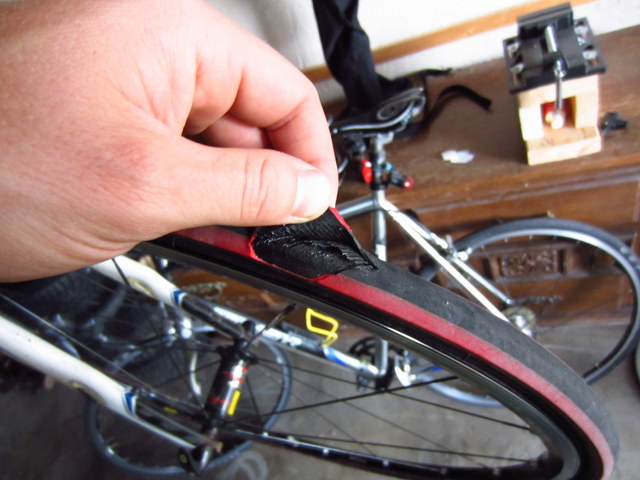
I ride a bike to and from work several days a week (when I’m commuting). My office was small so it seemed easier to store it outside rather than indoors. So, I started researching whether a bike can be stored outside, and put together this helpful article to explain it.
Can a bike be stored outside? A bike can be stored outside, however, it will cause a range of problems with your bike if it is stored for longer than a month without protection from the rain and wind. The more time the bike spends outside uncovered the more damage will occur to the bicycle.
Many bicycle owners use a cover to protect their bikes from the elements, but there are a few tricks to using a bike cover so that it doesn’t blow away in the wind, and some of the specialist bike covers are a waste of money.
So below, I’ll tell you the best way to set up a cover for your bike outside, and some helpful tips to increase the life of your bike when storing it outside.
How Can I Protect My Bike When I Store It Outside?
Put it under an overhang
If you have a part of the house that sticks out and provides a bit of rain cover, this is a good option until you get a bike cover, but when it is windy your bike will still get wet as the run comes in sideways.
Use a cover
This is by far the best way to go and provides you with all the protection you need. A tarpaulin is a good option for this. You may have a tarpaulin lying around which you only use when you go camping or out on the boat.
Put it under the deck or patio
Some decks have a lot of space underneath and have reasonable access where you can slide your bike underneath. You will likely want to put something on the ground so that it doesn’t get too dusty.
Half a cubic meter of local rocks such as scoria, or pebbles would work well to keep the bike dry. Because the underside of decks can become wet and muddy when it rains for prolonged periods.
How the Elements Affect Your Bike
When a bike is stored outside it also gets exposed to the wind. The wind on its own is not bad for the bike and can help dry it, but the dust begins to build up and clog the gears, and the chain.
Do you live near the sea? Your bike will be exposed to more salt, which rots aluminum and alloy parts. When you leave it outside without a cover it is exposed to double or triple the salt.
A cover should be used that has eyes on the side. This allows for the use of a rope to fix it to something so that it doesn’t blow away in the wind.
Here’s a picture of how it should look.
Notice how both ends are tied down. If you are buying a specifically designed bike cover ensure it has places on both ends to fix it to a fence or hook.
Is it OK for a Bike to Get Rained on?
If a bike is rained on it will cause more rust to form. Rust is the brown/red dusty and soft material that the metal turns into when it comes in contact with water and air. Almost all bikes are made out of metal which rusts when exposed to water for long periods. I wrote a helpful article about how this happens, and why you should try to avoid it [here].
It is not a good idea to leave your bike where it can get rained on regularly.
How should I prepare my bike for storage outside?
Before you store your bike outside you should clean and lube the entire bike, but this should be done on a regular schedule and not just when you are storing your bike.
I’ll explain how to do a simple regular service on your bike below which should be done before storing it outside or if you haven’t done it in a while:
What happens when you don’t service your bike?
- Increased rate of chain wear.
- Reduced flexibility of chain links.
- Added wear on derailleur assemblies and drivetrain cogs.
- Impaired shifting performance.
- Braking only works on one wheel
- Wheels are wobbly or brush up against the frame.
Firstly, let’s look at the chain:
A lubricant will: Provide a barrier against dirt. Dirt increases the wear on a bike but scratches the metal as it gets caught in between the chain links and other parts of the bike.
You want to use a lubricant that has Teflon because it is super effective at repelling water and dirt. Most chain specific lubricants from a bicycle supply store have Teflon, whereas a general-purpose lube will not.
The type of lubricant will depend on your climate below is a description of the different lubrication types and what climate they are ideal for.
Light Oil
Ideal For:
Dry climates such as deserts, or areas with little to no rainfall.
Description:
These oils are not very water-resistant, but provide an invisible barrier that protects the bike from dust.
Thick Grease:
Ideal For:
Very wet conditions.
Description:
This type of lubricant is the same used on motorcycles. It is very water-resistant. A trick to get better coverage is to mix in a small amount of solvent.
It will thin the lube but will evaporate off giving the lubricant more penetration between the chain links and gears.
This type of lube must be inspected and changed fairly regularly because it tends to hold dust.
Wax
Ideal For:
Very dry conditions
Description:
This lubricant is very good at repelling dirt in very dry conditions. If it doesn’t get wet it can last for months.
Spray Lubricants
Ideal For:
These types of lubricants are easy to apply, but they do not work.
Sometimes they can damage the bike by removing any lubricant that is present and leaving the chain exposed to the elements.
Check all tire pressures are a nice firmness for your comfort.
The easiest way is to ride it to the nearest petrol station unless you own an air compressor in your home. In which case, the attachment can be purchased.
The pressure a tire should be pumped to is printed on the side of a tire.
A general range is:
Thin tires with the no tread (Road tires) about: 80 to 130 psi
Mountain bike tires about: 25 to 35 psi
Waterblast the bike at a self-service car wash or using your water blaster.
It is a good idea to apply soap, or all-purpose cleaner like simple green to break down the grease.
After the bike has been water blasted lube will need to be reapplied. So try to water blast your bike before you apply lubricant.
Check both the front and rear brakes work easily. Sometimes they can jam and the brake will be permanently resting on the tire making it difficult to ride. If a rider falls from their bike then the brakes may come apart as the bike hits the ground. If they need to be replaced or put back on it’s a little bit tricky, so check out this helpful article [here]
Is hanging a bike bad?
Hanging your bike inside seems like a good option because setting up a cover, taking it off, and putting it back again each time is a bit time-consuming. I went to a bike shop the other day and saw them hanging bikes this way.
It is a good idea to hang up a bike. It does not damage the bike in any way. Bike shops frequently hang their bikes up this way. It is a convenient way to store a bike inside.






